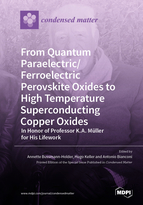From Quantum Paraelectric/Ferroelectric Perovskite Oxides to High Temperature Superconducting Copper Oxides -- In Honor of Professor K.A. Müller for His Lifework
A special issue of Condensed Matter (ISSN 2410-3896). This special issue belongs to the section "Superconductivity".
Deadline for manuscript submissions: closed (15 September 2020) | Viewed by 65926
Special Issue Editors
Interests: ferroelectrics; antiferroelectricss; multiferroics; magnetism; phase transitions; superconductivity; nonlinear interactions
Special Issues, Collections and Topics in MDPI journals
Interests: magnetism; superconductivity; critical phenomena and phase transitions in low-dimensional magnetic systems; biomolecular physics; muon and muonium physics in condensed matter; microscopic and macroscopic properties of novel superconductors (cuprates, magnesium diboride, iron-based superconductors) and related magnetic systems; vortex matter in cuprate and other novel superconductors; colossal magnetic resistance (CMR) in manganites; isotope and polaronic effects in novel superconductors and manganites; pressure effects in novel superconductors; microscopic magnetic properties of magnetic and superconducting multilayer structures; electronic; magnetic and structural properties of multiferroic systems; Experimental methods: Mössbauer effect, bulk and low-energy muon-spin rotation (muSR), electron paramagnetic resonance (EPR), nuclear magnetic resonance (NMR), nuclear quadrupole resonance (NQR), neutron scattering, SQUID and torque magnetometry, transport experiments
Interests: synchrotron radiation research; protein fluctuations; active sites of metalloproteins; origin of life; selected molecules in prebiotic world; quantum phenomena in complex matter; quantum confinement; superstripes in complex matter; lattice complexity in transition metal oxides; high Tc superconductors; valence fluctuation materials
Special Issues, Collections and Topics in MDPI journals
Special Issue Information
Dear Colleagues,
This special issue of the journal is dedicated to the lifework of Professor Dr. Dr. h.c. multi. K. Alex Müller. This comprises multiple contributions to solid state physics starting early on in the field of structural phase transitions in perovskite oxides with emphasis on electron-paramagnetic resonance (EPR) investigations of those compounds. From those essential knowledge was gained on the order parameter of the phase transition and the driving mechanism. The suppression of the expected transition to the polar state in SrTiO3 was coined quantum paraelectric by him and has raised enormous interest in the community. Further EPR studies by him are related to resonances of impurity ions in diverse perovskites and related crystals, thereby discovering experimentally negative U-centers later on established theoretically. The Jahn-Teller effect attracted his attention early on and played a key role in the discovery of superconductivity where especially the Jahn-Teller polaron was at the heart of it. The polaron has been shown to be vital also in Fermi glasses, LaBaNiO4 and doped polythiophene. The concept of the Jahn-Teller polaron in connection with perovskite oxides inspired him to search for superconductivity in these compounds which – as everybody knows – was successful. Together with Georg Bednorz he discovered high temperature superconductivity in LaBaCuO with the highest transition temperatures at ambient pressure ever observed which was awarded with the Nobel prize only one year later. This discovery caused an enormous world-wide breakthrough in basic research as well as in possible applications. In order to explain these findings, the polaron concept and the bipolaron condensation were suggested by him. In order to verify this concept he proposed to search for unconventional isotope effects which have indeed been observed in cuprates.
Contributions to all fields mentioned above and related topics are welcome.
Please kindly noted that the fees for all submissions to our Special Issue will be wavied.
Prof. Dr. Annette Bussmann-Holder
Prof. Dr. Hugo Keller
Prof. Antonio Bianconi
Guest Editors
Manuscript Submission Information
Manuscripts should be submitted online at www.mdpi.com by registering and logging in to this website. Once you are registered, click here to go to the submission form. Manuscripts can be submitted until the deadline. All submissions that pass pre-check are peer-reviewed. Accepted papers will be published continuously in the journal (as soon as accepted) and will be listed together on the special issue website. Research articles, review articles as well as short communications are invited. For planned papers, a title and short abstract (about 100 words) can be sent to the Editorial Office for announcement on this website.
Submitted manuscripts should not have been published previously, nor be under consideration for publication elsewhere (except conference proceedings papers). All manuscripts are thoroughly refereed through a single-blind peer-review process. A guide for authors and other relevant information for submission of manuscripts is available on the Instructions for Authors page. Condensed Matter is an international peer-reviewed open access quarterly journal published by MDPI.
Please visit the Instructions for Authors page before submitting a manuscript. The Article Processing Charge (APC) for publication in this open access journal is 1600 CHF (Swiss Francs). Submitted papers should be well formatted and use good English. Authors may use MDPI's English editing service prior to publication or during author revisions.








